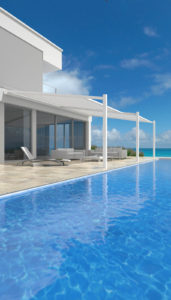
for larger installations. Photo: Renson Inc.
More consumers are seeking protection from the sun, heat, bugs and high energy bills, and shading system manufacturers are surrounding the market, indoors and out.
The U.S. market is looking rather attractive these days to manufacturers of shade systems. For a variety of reasons—energy conservation, protection from the elements and insects, heat and glare reduction—screens, shades, awnings and other shade products are receiving increased attention from residential and commercial consumers who want to establish a buffer zone between themselves and Mother Nature (or their neighbors), and enhance their décor and overall comfort at the same time. It’s not a new concept, but many U.S. consumers are just now starting to embrace these items, individually and in combination, and that translates into good growth opportunities for shading systems manufacturers and their suppliers.
This is part of the reason that Renson Inc., a manufacturer of custom exterior sun shading products and dynamic sun shading systems headquartered in Belgium, opened a U.S. subsidiary in El Segundo, Calif., three years ago, says Gilles Vanpoucke, business development manager, North America.
According to Vanpoucke, there’s a decided lag between the European and the U.S. markets when it comes to shade systems, with Europe taking the lead, thanks to that area’s much earlier focus on energy savings and outdoor living.
Creating consumer awareness
“It’s about 10 years behind here,” says Vanpoucke. “But we realized several years ago that the U.S. market will evolve into what the European market is today. It won’t happen overnight, but one reason why we opened a sales office here is to create awareness and raise knowledge about what is possible. We hope that in a couple of years this market will catch on to what’s going on in Europe and start using some of the technology and techniques.” The company also plans to open a showroom in New York City and a manufacturing facility in Dallas, Texas.
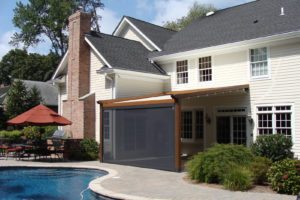
Larry Bedosky, director of marketing for Eclipse Shading Systems LLC, says that for retractable awning systems, much of the product evolution has been driven and refined by the European market, even though these products initially got their start in the U.S. Headquartered in East Middletown, N.Y., the company is a wholesale manufacturer of custom-made, mostly exterior shade products, such as retractable awning systems, exterior screens and interior shades. Like Vanpoucke, he says the European market is ahead of the U.S.; the company often looks to southern Europe to see what trends are in play there. The market here is catching up, however, particularly the exterior shade segment, which Bedosky says is growing rapidly, driven by demand for side-fabric retention/zippered screens.
In fact, zippered screens are starting to replace non-retained-edge systems, says Don Smallwood, president of abc Sun Control Systems LLC. According to Smallwood, people prefer these systems because they’re bug-proof and offer increased wind resistance. Headquartered in North Hollywood, Calif., the company is a wholesale manufacturer of custom-made retractable shading systems like awnings, vertical drop screen systems, roofs and fabric tension systems. Most of their products are for exterior shading.
Interestingly, Smallwood thinks that China could have a hand in boosting awareness of and demand for shade systems. More of these products are coming in from that country, and their lower prices could draw new customers to the market. This could initially frustrate manufacturers of higher-end custom systems, he adds, but the typically lower quality of imported products would eventually drive these consumers to upgrade to better shade systems when these cheaper ones disappoint or fail too quickly.
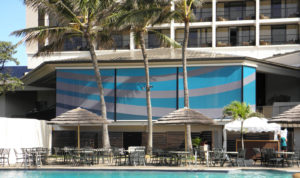
Technology and fabric
Advancements in technology—driven by new developments in electronics and motorization and fabric performance—have enabled shading systems manufacturers to significantly expand their offerings, with the ability to meet almost any consumer need. For example, when Smallwood purchased the company in 2003 (abc Sun Control was founded in 1979) it offered only six products—one lateral arm awning, two exterior screens, two drop-arm awnings and one interior manual screen. Now the company provides 62 different retractable shading systems, including retractable roofs, just added this January.
Smallwood is enthusiastic about the potential market for retractable roofs, having recently sold three of these new—and expensive—systems. The roofs incorporate a very heavy vinyl fabric—19 ounces per square yard—reinforced with a polyester substrate. One of the fabrics deployed for this application is Ferrari STAM 6002.
“I like this fabric because of its workability and availability,” Smallwood explains. “These are among the key qualities I look for in a fabric, along with dimensional stability, weight and product warranty.”
Another product that has been very successful for his company is the SecureZip Motorized, a retained-edge/zipper screen system, says Smallwood. The fabrics used in this system include a PVC-coated fiberglass fabric from Mermet or Ferrari Soltis, a PVC-coated polyester core fabric made under tension to give it better stability.
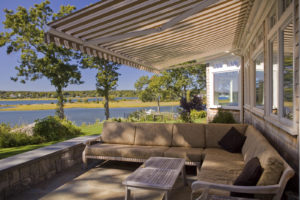
A motorized, retractable exterior screen—the Eclipse E-Zip solar shade and insect screen—is also one of the hottest sellers for Eclipse, says Bedosky. The side-fabric retention/zippered screens are typically constructed from fiberglass or a polyester core yarn covered in PVC.
“For sun issues, like heat and glare, we offer 10-to-3 percent openness fabrics, but 5 percent is most common, since it provides a good balance of sun protection and visibility,” says Bedosky. “The fabric for insect screens has an openness of greater than 35 percent. It stops even the smallest flying insects, but does very little for sun control.” The company also offers the E-Zip and other exterior screens with solid fabrics, such as Sunbrella®.
“When it comes to screens, it’s essential that the fabric is very stable in variable weather conditions,” he adds. “We have half-inch adjustability for the fabric to change dimension—some manufacturers have zero adjustability—so the screen fabric has to be very dimensionally stable. If the fabric alters shape due to changing temperatures, it can cause the screen to malfunction, creating service calls.”
KE Durasol Awnings Inc. globally sources a variety of PVC, mesh and acrylic fabrics, including materials from companies like Sunbrella, Sattler, Para, Ferrari and Mermet, says Christopher Taylor, sales and marketing director. Headquartered in Chester, N.Y., the company serves both residential and commercial customers, offering a variety of products including (but not limited to) retractable awnings, interior and exterior screen shades, retractable glass barriers and a line of waterproof retractable enclosures dubbed the Gennius, about which Taylor is especially enthusiastic.
The Gennius enclosure “combines the beauty of a pergola, the flexibility of a retractable awning and the warmth and comfort of a room addition,” according to the company website, and is versatile enough to cover a small deck, a large patio or an expansive pavilion. “This is an exterior product designed to let you enjoy the natural elements during the best of weather conditions,” Taylor says. “But it excels when presented with adverse conditions. It manages rainwater with integrated gutters, downspouts and leaders; Ferrari 502 and 602 Précontraint are included in the design.”
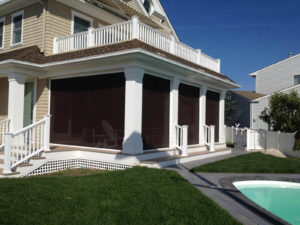
Introduced last year in Europe, and now available in the U.S., is Renson’s Panovista®, an exterior sun shading system for glass-on-glass corner windows without cables, where the two screens meet, says Vanpoucke. He describes the system as a sunscreen for corner windows that, because of its design and construction, is also insect-proof. The fabric, a fiberglass core with polyester coating, is available in 5, 3 or 1 percent open mesh.
“We work with almost every shade manufacturer on the market—Ferrari, Dickson, Copaco,” says Vanpoucke. “Fiberglass fabrics are ideal for bigger surfaces and free-standing screens.”
Renson also offers retractable, translucent and waterproof fabric roofs with integrated gutter systems (the Lagune®, which has integrated fabric screens or sliding panels on its open sides, made from the same material as the Panovista; and the Lapure®, which doesn’t come with screens or panels) that incorporate Dickson Sunworker Cristal fabric, which has waterproofness and translucent characteristics, says Vanpoucke. The fabric allows the sun’s rays to come through while still providing UV protection.
Making it personal
Headquartered in Tukwila, Wash., Rainier Industries Ltd. serves both residential and commercial customers with shade options such as motorized, retractable screens and awnings, as well as fixed-frame awnings. The Rainier Power Screen, which utilizes a variety of mesh fabrics, incorporates a side-retention system, keeping the screen mesh stable—keeping bugs out and reducing heat inside the home.
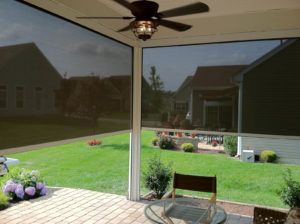
Heat reduction is one of the three most often mentioned needs the company hears from residential customers hunting for shade systems, says Jennie Day, marketing manager. Customers are also looking to eliminate glare on computer screens and televisions and protect furnishings and flooring from fading.
Commercial customers also want protection from the sun, Day says. But at the same time, they’re utilizing screens to enhance their brand identity by printing logos and other graphics on them. In this way, the screens also function as attractive signage, she adds.
“We have an in-house printing shop and the ability to print on screen fabric,” says Day. “We’ve printed a number of screens for commercial applications that allowed the businesses to strengthen their brand identity, while at the same time providing shade to the interior space. And some residential customers have added printed screens to personalize their homes.”
Bedosky says commercial customers are adding graphics to screens and retractable interior mounted shades to achieve greater “utility of value.” Compared to the residential market, the commercial sector also typically needs more retractable roof systems that can be extended during inclement weather. The fabrics used on the commercial side are often the same as those deployed in residential applications.
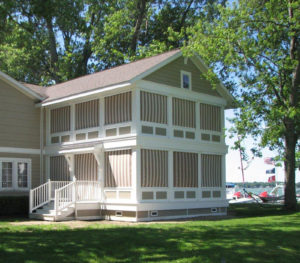
The fabrics may stay the same between commercial and residential jobs—although commercial customers like those logos and graphics—but in many cases, different installation methods are required, such as when the building has a completely glazed (glass) facade, says Vanpoucke. “Commercial projects are usually also asking for bigger measurements for their shading products.”
“Everyone seems to want to cover larger and larger areas, especially restaurants,” says Smallwood, and commercial customers also frequently have more stringent fire-resistance requirements.
In the future, Bedosky believes that the U.S. market will come to reflect the current European trends and foresees continued product refinement in performance, style and comfort. Customers will increasingly seek out quality solutions to address their environmental concerns, especially when energy costs surge again. “And the better that we in this industry can service these customers and solve their problems, the stronger our sector of the industry will be,” Bedosky says.
Pamela Mills-Senn is a freelance writer based in Long Beach, Calif.
Wishful thinking—and planning
Shade system manufacturers are happy with the fabrics they’re using, but this doesn’t mean there isn’t a wish list. We asked, “If you could create the ideal fabric for your products, what would it be?”
Eclipse Shading Systems LLC
Sunbrella® makes an engineered fabric called Clarity, which features a durable polyurethane back coating for water resistance. Unlike standard Sunbrella fabric, water doesn’t bead up. Instead, it wets out the surface, a characteristic of the fabric’s anti-streaking/self-cleaning technology. This fabric is available for stationary awnings and umbrellas but not for retractable deck or patio awnings. But this concept is appealing to me. I’d also like to have a self-cleaning fabric with the possibility of photoelectric cells incorporated to power the unit and/or accessories.
Larry Bedosky, director of marketing
ABC Sun Control Systems LLC
We’d like a lighter-weight, waterproof fabric that meets fire codes. We’d use this fabric for tension systems for schools, restaurants, health care facilities and so on, all of which require NFPA 701 certification. The fabrics currently available meeting the requirement are typically heavier and harder to work with, which is why a lighter-weight fabric would be appealing.
Don Smallwood, president
KE Durasol Awnings Inc.
In the coming years we’d like to see the incorporation of photovoltaics in our fabric offerings. This technology would better help this industry with the growing green movement and help consumers lower, if not eradicate, most of their energy costs.
Christopher Taylor, sales and marketing director
Renson Inc.
Windows are getting bigger and bigger, so it would be nice to see a screen that can be taller than the ones currently on the market. It happens a lot that we need to weld two fabric bands onto each other to achieve bigger measurements. This way there’s a seam visible, which isn’t good for the aesthetics of the screen.
Gilles Vanpoucke, regional sales manager, North America
Out the window
A large part of Leland, N.C.-based Technical Coating International Inc.’s (TCI) business is contract work for the indoor window fashions market, says David Stanbury, vice president of sales. It’s no secret that, as much as we like the light, there is energy loss through windows.
“There’s a lot of push to have window fashions have more energy-saving features,” he says. This can be done by incorporating more layers in the structure using different films and fabrics in the laminating process, depending on what the customer wants the end product to accomplish. That’s where some of the discussion picks up, because energy savings using window coverings has not yet been quantified.
But that’s changing.
TCI has been working with the newly formed Attachments Energy Rating Council (AERC), which is charged with administering a ratings, labeling and certification program for window attachments. (The AERC is an independent, nonprofit organization which will provide accurate and credible information about the energy performance of window attachments to help homeowners, architects and builders make informed decisions about window attachment products.)
Analysis conducted by the U.S. Department of Energy (DOE) has shown that window attachments (shades, shutters, storm windows) have the potential to save significant energy in residential and commercial buildings. The Window Coverings Manufacturers Association (WCMA) has been awarded DOE funding to create a comprehensive rating, labeling and certification program for window attachments, administered by the AERC.
Ron Paratore with Trivantage, chairman of the Professional Awning Manufacturers Association (PAMA), is also working with AERC on the new energy rating system. In phase one, he says, the council will deliver ratings on energy savings of mostly interior window attachments, possibly before the end of 2016. Phase two, which is where PAMA will be able to contribute more, he says, will concern exterior window attachments such as roller screens, awnings and solar screens, especially retractable systems. “PAMA is getting involved because this would be a direct benefit to our members,” he says, “as well as attract new manufacturer members.” Results should be available in early 2017.
 TEXTILES.ORG
TEXTILES.ORG


